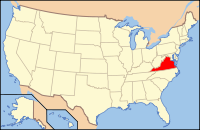Scott County, VA
| Scott County, Virginia | |
|---|---|

Scott County Courthouse
|
|
 Location in the U.S. state of Virginia |
|
 Virginia's location in the U.S. |
|
| Founded | November 24, 1814 |
| Named for | Winfield Scott |
| Seat | Gate City |
| Largest town | Gate City |
| Area | |
| • Total | 539 sq mi (1,396 km2) |
| • Land | 536 sq mi (1,388 km2) |
| • Water | 3.1 sq mi (8 km2), 0.6% |
| Population (est.) | |
| • (2015) | 23,177 |
| • Density | 43/sq mi (17/km²) |
| Congressional district | 9th |
| Time zone | Eastern: UTC-5/-4 |
| Website | www |
Scott County is a county located in the U.S. state of Virginia. As of the 2010 census, the population was 23,177. Its county seat is Gate City. Scott County was formed by an act of the General Assembly on November 24, 1814 from parts of Washington, Lee, and Russell Counties and was named for Virginia born General Winfield Scott.
Scott County is part of the Kingsport–Bristol–Bristol, TN-VA Metropolitan Statistical Area, which is a component of the Johnson City–Kingsport–Bristol, TN-VA Combined Statistical Area, commonly known as the "Tri-Cities" region.
The early settlers found evidence of a former native village at the mouth of Stony Creek on the Clinch river.
Thomas McCulloch was the first white settler within the county, in 1769. Daniel Boone commanded several forts located here in 1774 during Dunmore's War, and several more were built in successive years. Even so, the Chickamauga Cherokee leader Bob Benge remained active in the area throughout this time, during the Cherokee–American wars, up until he was killed in 1794. By the times houses were built in the 1790s, the largely Scots-Irish population had increased by reason of its situation along the Wilderness Road. After Scott County was formed in 1814, the first court took place in 1815, and the first public schools in 1870.
...
Wikipedia
